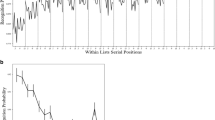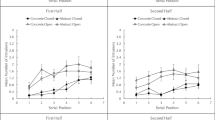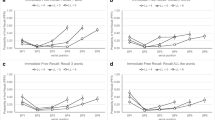Abstract
A total of 120 healthy volunteers were randomly assigned to four treatments (placebo, 0.1, 0.2, and 0.3 mg/kg) and three testing times (7 AM, 1 PM and 7 PM). Immediate and delayed free recall of word lists revealed consistent decreases in performance as oral diazepam dose increased from 0.1, 0.2, to 0.3 mg/kg. Paradoxically, as the dose increased, the number of predrug list words recalled also increased. A serial number-learning task displayed a pattern of delayed improvement of acquisition as the dose increased. Response times in a semantic-categories task were prolonged as the dose increased. Parallel recovery functions were observed for all doses and tasks. Full recovery after a single administration of 0.1, 0.2, and 0.3 mg/kg doses was estimated to occur after 3.5, 4.5, and 5.5 h, respectively. Several analyses were consistent with the view that acquisition and not retrieval was impaired by diazepam. There were no circadian interactions with the effects of the drug.
Similar content being viewed by others
References
Battig WB, Montague EW (1969) Category norms for verbal items in 56 categories: A replication and extension of the Connecticut category norms. J Exp Psychol (Monogr) 80:1–46
Brown J, Lewis V, Brown MW, Horn G, Bowes JB (1978) Amnesic effects of intravenous diazepam and lorazepam. Experientia 34:501–502
Castleden CM, George CF (1979) Increased sensitivity to benzodiazepines in the elderly. In: Crooks J, Stevenson IH (eds) Drugs and the elderly. University Park Press, Baltimore, pp 169–178
Clarke PRF, Eccersley PS, Frisby JP, Thornton JA (1970) The amnesic effect of diazepam (Valium). Br J Anaesth 42:690–697
Dundee JW, Pandit SK (1972) Anterograde amnesic effects of pethidine, hyoscine and diazepam in adults. Br J Pharmacol 44:140–144
George KA, Dundee JW (1977) Relative amnesic actions of diazepam, flunitrazepam and lorazepam in man. Br J Clin Pharmacol 4:45–50
Ghoneim MM, Mewaldt SP, Thatcher JW (1975) The effect of diazepam and fentanyl on mental, psychomotor and electroencephalographic functions and their rate of recovery. Psychopharmacologia 44:61–66
Ghoneim MM, Mewaldt SP, Berie JL, Hinrichs JV (1981) Memory and performance effects of single and 3-week administration of diazepam. Psychopharmacology 73:147–151
Ghoneim MM, Mewaldt SP, Hinrichs JV (1984) Dose-response analysis of the behavioral effects of diazepam: II. Psychomotor performance, cognition and mood. (Psychopharmacology 82: 296–300)
Greenblatt DJ, Allen MD, Shader RI (1977) Toxicity of high-dose flurazepam in the elderly. Clin Pharmacol Ther 21:355–361
Gregg JM, Ryan DE, Levin KH (1974) The amnesic actions of diazepam. J Oral Surg 32:651–664
Harry TVA, Richards DJ (1972) Lorazepam — a study in psychomotor depression. Br J Clin Pract 26:371–373
Johnson LC, Chernik DA (1982) Sedative-hypnotics and human performance. Psychopharmacology 76:101–113
Jones DM, Lewis MJ, Spriggs TLB (1978) The effects of low doses of diazepam on human performance in group administered tasks. Br J Clin Pharmacol 6:333–337
Kleinknecht DA, Donaldson D (1975) A review of the effects of diazepam on cognitive and psychomotor performance. J Nerv Ment Dis 161:399–411
Kothary SP, Brown ACD, Pandit UA, Samara SK, Pandit SK (1981) Time course of antirecall effect of diazepam and lorazepam following oral administrations. Anesthesiology 55:641–644
Linnoila M, Erwin CW, Brendle A, Simpson D (1983) Psychomotor effects of diazepam in anxious patients and healthy volunteers. J Clin Psychopharmacol 3:88–96
Mewaldt SP, Hinrichs JV, Ghoneim MM (1984) Diazepam and memory: Support for a duplex model of memory. Mem Cognition (in press)
Millar K, Styles BC, Wastell DG (1980) Time of day and retrieval from long-term memory. Br J Psychol 71:407–417
Paivio A, Yuille JC, Madigan SA (1968) Concreteness, imagery and meaningfulness values for 925 mouns. J Exp Psychol [Suppl) 76:1–25
Petersen RC, Ghoneim MM (1980) Diazepam and human memory: influence on acquisition, retrieval, and state-dependent learning. Prog Neuropsychopharmacol 4:81–89
Reinberg A, Smolensky MH (1982) Circadian changes of drug disposition in man. Clin Pharmacokinet 7:401–420
Thorndike EL, Lorge L (1944) The teacher's word book of 30,000 words. Columbia University Press, New York
Wilson J, Ellis FR (1973) Oral premedication with lorazepam (Ativan): A comparison with heptabarbitone (Medomin) and diazepam (Valium). Br J Anaesth 45:738–744
Author information
Authors and Affiliations
Rights and permissions
About this article
Cite this article
Ghoneim, M.M., Hinrichs, J.V. & Mewaldt, S.P. Dose-response analysis of the behavioral effects of diazepam: I. Learning and memory. Psychopharmacology 82, 291–295 (1984). https://doi.org/10.1007/BF00427672
Received:
Accepted:
Issue Date:
DOI: https://doi.org/10.1007/BF00427672




